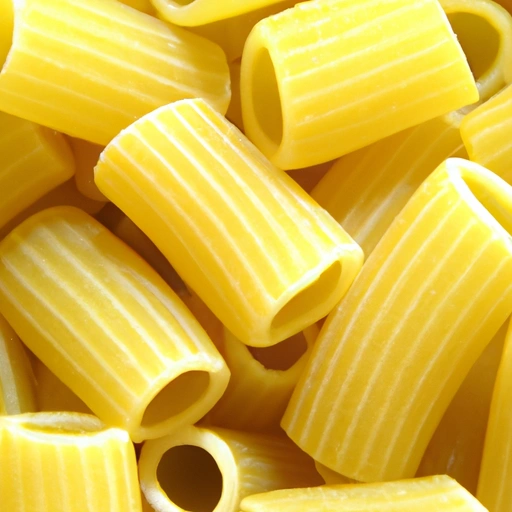Rigatoni
Description

Rigatoni is a popular type of pasta known for its large, tube-shaped structure with ridges on the outside and a wide, hollow center. The name 'rigatoni' comes from the Italian word 'rigato' which means 'ridged' or 'lined' and aptly describes the pasta's surface. Rigatoni pieces are larger than penne and are typically about 1.5 inches (38 mm) in length with a 0.5 to 0.75 inches (12 to 19 mm) diameter.
In recipes, rigatoni is often measured in cups or grams. A standard serving size is generally considered to be 2 ounces (56 grams) of dry pasta, which equals approximately 1/2 cup (120 ml) when cooked. In European recipes, rigatoni is often measured in grams or deciliters, with a typical portion being about 75 to 100 grams for a single serving.
Common uses
Rigatoni is commonly used in a variety of pasta dishes. It's particularly well-suited for baked pasta dishes, hearty meat sauces, and in casseroles where its ridges and large size help to trap sauce and cheese. Its texture holds up well to robust flavors and ingredients, making it a favorite choice for many pasta lovers.
Nutritional value
Calories
A 2-ounce (56-gram) serving of dry rigatoni typically contains approximately 200 calories.
Protein
This serving size offers around 7 grams of protein, an essential macronutrient for muscle repair and growth.
Fat
Rigatoni is naturally low in fat, with a serving containing less than 1 gram of total fat.
Carbohydrates
The majority of rigatoni's calories come from carbohydrates, with about 42 grams per serving.
Vitamins
While not a significant source of vitamins, some enriched rigatoni pasta may contain added B vitamins.
Minerals
Rigatoni provides minerals such as iron and magnesium, especially if made from whole-grain flour.
Health benefits
The carbohydrates in rigatoni provide energy for daily activities, while the dietary fiber, particularly in whole grain variations, supports digestive health. The protein content contributes to muscle maintenance and repair.
Potential risks
Consuming pasta like rigatoni in excessive amounts may lead to weight gain, and those with gluten sensitivities or celiac disease should avoid traditional wheat-based rigatoni.
Common recipes
Rigatoni is frequently used in dishes like Rigatoni al Segreto, Rigatoni alla Norma, and classic baked ziti. It also stars in pasta salads and is often served with chunky vegetable or meat sauces.
Cooking methods
Rigatoni is boiled in salted water until al dente, which typically takes between 12 to 15 minutes. It can also be baked or used in skillet dishes.
Pairing with other ingredients
This type of pasta pairs well with robust tomato-based sauces, cream sauces, and can hold its own with additions like sausage, mushrooms, and various cheeses.
Summary
Rigatoni is a beloved pasta shape that originated in Italy and has become a staple in many different cuisines worldwide. Its ridges and large size make it perfect for a variety of sauces and cooking methods, and it remains a popular choice for cooks looking for a hearty and satisfying pasta option.